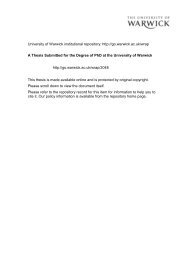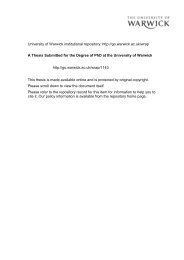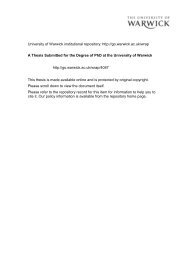From Page to Screen - WRAP: Warwick Research Archive Portal ...
From Page to Screen - WRAP: Warwick Research Archive Portal ...
From Page to Screen - WRAP: Warwick Research Archive Portal ...
Create successful ePaper yourself
Turn your PDF publications into a flip-book with our unique Google optimized e-Paper software.
narrative for a second time. Once read, text disappears, <strong>to</strong> be retrieved only with<br />
difficulty and some active memorizing has <strong>to</strong> take place.<br />
While writing technology makes a non-linear arrangement possible, it also encourages<br />
long linear arguments and traditional beginning - (complex and long) development - end<br />
plot narratives, .because of the spatial presence of a text and the possibility always <strong>to</strong> go<br />
back and reread. Orality does not favour such an arrangement, instead it favours an<br />
episodic structure as the natural way <strong>to</strong> tell a lengthy s<strong>to</strong>ry, ifonly because the experience<br />
ofreal life is more like a string ofepisodes than it is like a Freytag pyramid (of exposition,<br />
climax and solution). Walter Ong has argued for a strong link between developments of<br />
printing technology and the rise of the novel format: "The print world gave birth <strong>to</strong> the<br />
novel, which eventually made the definite break with episodic structure.?"<br />
Hypertext goes back <strong>to</strong> an episodic structure, favoured not only because of its affinity <strong>to</strong><br />
(postrmodem ideas of fragmented and multilayered life and an absence of grand<br />
narratives for the expression ofwhich the novel no longer seems appropriate, but also<br />
because of its parallels <strong>to</strong> oral (episodic) text in which only a short portion of the text is<br />
directly present in the moment ofnarration / on the screen.<br />
Interactive S<strong>to</strong>rytelling<br />
In an article that asks the very pertinent question as <strong>to</strong> whether it could be that<br />
"s<strong>to</strong>rytelling doesn't work very well ifthe user can interfere with it" and looks critically at<br />
new so-called interactive artforms, Charles Platt gives an example of the open<br />
endedness and flexibility that can be so appealing about oral narratives:<br />
As Barbara Hayes-Roth has pointed out, any parent who has made up a s<strong>to</strong>ry for a<br />
child knows that the child likes <strong>to</strong> have some control over it. The parent begins:<br />
"Once upon a time, there was a rabbit." "His name was Thomas!" says the child<br />
(whose name happens <strong>to</strong> be Thomas). "Yes, his name was Thomas. And he lived in<br />
a burrow » "In a field? Was it in a field?" "A big green field. And he had a friend <br />
do you know what the friend's name was?" "Urn - Samantha." "All right. One day,<br />
Thomas and Samantha went of <strong>to</strong> gather blackberries." ''But rabbits don't eat<br />
blackberries. Rabbits eat grass." "Most rabbits eat grass, but these were special<br />
rabbits." In this way, parent and child collaborate, and the s<strong>to</strong>ry evolves interactively."<br />
13Walter Ong, OralityandLiteracy (London and New York: Methuen.rcdz), P.149.<br />
14 Charles Platt, "Interactive Entertainment: Who writes it? Who Reads it? Who Need it?", Wired,<br />
vol.j, 00.9 (September 1995), 145-149,195-197 (P.147).<br />
Chapter 3 -page 95





